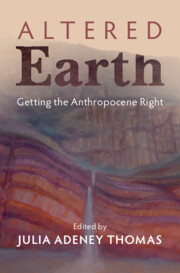Book contents
- Altered Earth
- Altered Earth
- Copyright page
- Dedication
- Contents
- Figures
- Foreword
- Acknowledgments
- Introduction: The Growing Anthropocene Consensus
- Part One Strata and Stories
- Part Two One Anthropocene; Many Stories
- Chapter 3 Earth System Science: Gravity, the Earth System, and the Anthropocene
- Chapter 4 Deep History and Disease: Germs and Humanity’s Rise to Planetary Dominance
- Chapter 5 Anthropology: Colonialism, Indigeneity, and Wind Power in the Anthropocene
- Chapter 6 The Ascent of the Anthropoi: A Story
- Chapter 7 Politics in the Anthropocene
- Chapter 8 Very Recent History and the Nuclear Anthropocene
- Chapter 9 Stratigraphy: Finding Global Markers in a Small Canadian Lake
- Chapter 10 Curating the Anthropocene at Berlin’s Haus der Kulturen der Welt
- Part Three Future Habitations
- Biographies of Chapter Contributors
- Index
Chapter 8 - Very Recent History and the Nuclear Anthropocene
from Part Two - One Anthropocene; Many Stories
Published online by Cambridge University Press: 24 March 2022
- Altered Earth
- Altered Earth
- Copyright page
- Dedication
- Contents
- Figures
- Foreword
- Acknowledgments
- Introduction: The Growing Anthropocene Consensus
- Part One Strata and Stories
- Part Two One Anthropocene; Many Stories
- Chapter 3 Earth System Science: Gravity, the Earth System, and the Anthropocene
- Chapter 4 Deep History and Disease: Germs and Humanity’s Rise to Planetary Dominance
- Chapter 5 Anthropology: Colonialism, Indigeneity, and Wind Power in the Anthropocene
- Chapter 6 The Ascent of the Anthropoi: A Story
- Chapter 7 Politics in the Anthropocene
- Chapter 8 Very Recent History and the Nuclear Anthropocene
- Chapter 9 Stratigraphy: Finding Global Markers in a Small Canadian Lake
- Chapter 10 Curating the Anthropocene at Berlin’s Haus der Kulturen der Welt
- Part Three Future Habitations
- Biographies of Chapter Contributors
- Index
Summary
Climate change history often (and rightly) highlights the plight of the Global South and poorer countries, but zeroing in on the nuclear Anthropocene shows how ubiquitous were radioactive toxins especially in the northern hemisphere. This story has been largely missed because, as military leaders detonated 520 nuclear bombs into the atmosphere from 1945-1963, the fallout that settled down became part of “background” or “natural” radiation. In the same decades that manmade radioactive isotopes began to circle the globe, so too did new classes of pesticides, herbicides, and chemical pollutants from new industries producing plastics, aluminum and a host of goods that contaminated landscapes. The blanketing of the earth with anthropogenic toxins was so encompassing, the scale so grand, that this major change to the planetary eco-system has been hard to discern. A focus on the nuclear Anthropocene reconfigures our sense of scale, and with it, time and human agency.
Keywords
- Type
- Chapter
- Information
- Altered EarthGetting the Anthropocene Right, pp. 182 - 195Publisher: Cambridge University PressPrint publication year: 2022



